I need help please In the early days of encryption ciphers s
I need help, please!!!!
In the early days of encryption, ciphers such as the Hill Cipher were used to encrypt messages being sent back and forth between two parties. The messages were encrypted so that If the message was captured in route, it would not be immediately readable. Your task is to ask the user to enter a message, ask die user to enter the encryption matrix, break your message into two rows, encrypt the message, and then save and display the encrypted message. The encryption matrix will have two columns, and two rows. Once you have encrypted the message you will save it in a variable called \"encrypted_message\" that allows your instructor to decrypt the message. We (your instructors) will then decrypt your message and see if your program worked correctly. You are allowed to work in teams of four, you select your teammates and the only one of you needs to upload your final file to Blackboard. If you complete the code by 11:59pm on Friday October 14, 2016, you will receive a bonus. Do not ask what die bonus is, everyone will be notified of the bonus, in class, at the same time. If you want the bonus, complete a perfectly functional program and upload it to Blackboard prior to the Friday night. As an example: When the following message is entered into the Command Window by the user. One if by land The program should convert the message into an array containing ASCII character codes, then reshaped. The encryption matrix is then multiplied by the reshaped array. When the above message is passed through this process using the following encryption array: encrypt = [110 2221 213 4769] The result is the following encrypted and reshaped array, ready to be transmitted: encrypted_message = [253000 82182 238092 221178 84382 227317 234200 1541417 174121 508803 474178 178381 485597 500330]Solution
We’ll introduce the cryptosystem by showing how it encrypts and then decrypts
a simple 15-character message, stored in a variable s:
>> s = \'This is a test!\'
s =
This is a test!
Then we’ll suggest some ways in which you can write more general functions for
encrypting and decrypting. Finally, we’ll use the ideas of this case to introduce
the concept of a public-key cryptosystem.
Encrypting a message. The first step of disguising the message is to convert
it into an array of numbers. The Matlab function double does exactly this when
applied to a variable containing the message:
>> double (s)
ans =
Columns 1 through 12
84 104 105 115 32 105 115 32 97 32 116 101
Columns 13 through 15
115 116 33
Matlab uses the standard computer character code (the so-called ASCII code) to
assign a different number to each letter and punctuation mark. A space is also
regarded as one of the characters of the message, and is translated — as you
can see in our example — to its own number, namely 32.
To apply a matrix-algebra encryption scheme to this numerical form of the
message, we begin by arranging the array of numbers into a 3 × 5 matrix. Matlab’s
reshape function does exactly this:
>> nnumb = reshape (double(s), 3, 5)
nnumb =
84 115 115 32 115
104 32 32 116 116
105 105 97 101 33
For convenience, we have here stored the resulting matrix in a new variable,
nnumb.
We now arrive at the crucial step of the encryption, in which we transform
15
this matrix to another 3×5 matrix. The transformation is effected by multiplying
our matrix on the left by a 3×3 matrix. Not any such matrix will do, however. To
make decryption possible, we must multiply by a 3 × 3 matrix whose entries are
all integers (whole numbers), and whose inverse has entries that are all integers.
For example, the integer matrix
>> m = [1 5 3; 2 11 8; 4 24 21]
m =
153
2 11 8
4 24 21
can be seen to meet our requirements for its inverse by applying Matlab’s inv
function:
>> inv(m)
ans =
39-33 7
-10 9-2
4 -4 1
Later in this case, we’ll have more to say about how such a matrix can be constructed.
We’re now almost ready to multiply by m. But because the printable characters
have ASCII codes in the range 32 to 126, we must first adjust the 3 × 5
message matrix by subtracting 32 from every element:
>> nnumb-32
ans =
52 83 83 0 83
72 0 0 84 84
73 73 65 691
Now the matrix must contain values in the range 0 to 94, and it is ready to be
transformed by matrix multiplication:
>> m*(nnumb-32)
ans =
631 302 278 627 506
1480 750 686 1476 1098
34691865 1697 3465 2369
This transformed matrix does not contain printable ASCII codes, but we can
take care of that via the following further adjustment:
>> ncode = mod (m*(nnumb-32), 95) + 32
ncode =
93 49 120 89 63
87 117 53 83 85
81 92 114 77 121
16
Here we have used the mod function to divide each element by 95 and keep only
the remainder, and then we have added 32 so that the values again range from
32 to 126.
All that remains to be done is to convert these numbers back to an array of
characters. We use Matlab’s char function to convert the numbers to characters,
and reshape again to put them back into a 1 × 15 array:
>> scode = reshape (char(ncode), 1, 15)
scode =
]WQ1u\\x5rYSM?Uy
The last line gives the coded message to be sent. Notice that the same letter in
two different places in the original message can go into two different letters in
the coded message. For example, the i in this becomes a Q while the i in is
becomes a \\.
Decrypting a message. If you were to receive the message ]WQ1u\\x5rYSM?Uy,
you would have to reverse the above steps to decrypt it and recover the original.
Fortunately, a way of doing this is not hard to figure out, because the reversed
steps of decryption are much the same as the original steps of encryption. The
only poentially hard step is the reversal of the multiplication by the matrix m —
and that is where some elementary linear algebra comes in.
To see how the encryption steps would be reversed, it helps to write them
down completely. In words, the steps can be described as follows:
1. Translate the 15-character message to a 3 × 5 matrix of ASCII
character codes.
2. Transform the matrix to an encrypted 3×5 matrix of ASCII character
codes, by:
(a) subtracting 32 from each element of the matrix;
(b) multiplying the matrix by a given 3 × 3 matrix;
(c) reducing each matrix element to its remainder modulo 95;
(d) adding 32 to each element of the resulting matrix.
3. Translate the encrypted 3×5 matrix of ASCII character codes to
an encrypted 15-character message.
If you like descriptions that have a more mathematical flavor, then you might
prefer the following:
1. Translate a message string s to a 3 × 5 matrix A.
2. Use the given 3 × 3 matrix M to compute the encrypted matrix
A = M(A 32) mod 95 + 32.
3. Translate A to an encrypted string s
.
Either way, these steps can be implemented as three Matlab statements:
nnumb = reshape (double(s), 3, 5)
ncode = mod (m*(nnumb-32), 95) + 32
scode = reshape (char(ncode), 1, 15)
17
These are exactly the three assignments that we have already derived in the
course of illustrating the encryption procedure.
To reverse the encryption steps, we must first undo step 3, then step 2,
then step 1. Observe however that steps 1 and 3 merely translate a message
between two representations, one as a string of characters and one as a matrix
of numbers. Thus step 1, applied to encrypted string ]WQ1u\\x5rYSM?Uy, undoes
step 3. Furthermore step 3, applied to a decrypted matrix, will undo step 1.
It remains for us to say how to reverse step 2. The essential idea here is that,
since the given 3 × 3 matrix has an inverse, the way to undo multiplication by
that matrix is simply to multiply by that matrix’s inverse. (There are faster ways
that we’ll get to later, but multiplication by the inverse will do fine for now.) As
for the other work of step 2, it turns out that exactly the same operations in
the same order will undo the original encoding. This is the one aspect of the
decryption procedure whose correctness is a bit tricky to establish, so we won’t
interrupt the presentation to give the proof here.
In summary, our analysis shows that decryption consists of basically the
same operations as encryption, with a few minor changes. We can thus proceed
to describe the decryption procedure in much the same terms that we used for
the encryption:
1. Translate the 15-character encrypted message to a 3 × 5 matrix
of ASCII character codes.
2. Transform the encrypted matrix back to the original 3×5 matrix
of ASCII character codes, by:
(a) subtracting 32 from each element of the matrix;
(b) multiplying the matrix by the inverse of a given 3×3 matrix;
(c) reducing each matrix element to its remainder modulo 95;
(d) adding 32 to each element of the resulting matrix.
3. Translate the original 3×5 matrix of ASCII character codes back
to the original 15-character message.
If you prefer the more mathematical description, you can think of the decryption
procedure as working in this way:
1. Translate an encoded string s to a 3 × 5 matrix A
.
2. Use the given 3 × 3 matrix M to compute the original matrix
A = M1(A 32) mod 95 + 32.
3. Translate A to the original string s.
With these steps being almost the same as the encryption steps, we can use
almost the same Matlab code. The only major changes are to replace the string
s by the encrypted string scode at the beginning, and to multiply by the inverse
matrix inv(m) rather than by m:
ncode = reshape (double(scode), 3, 5)
nnumb = mod (inv(m)*(ncode-32), 95) + 32
sorig = reshape (char(nnumb), 1, 15)
18
It remains only to type these statements into Matlab to check that they work.
The first one,
>> ncode = reshape (double(scode), 3, 5)
ncode =
93 49 120 89 63
87 117 53 83 85
81 92 114 77 121
produces the same encoded matrix that we saw before. The second,
>> nnumb = mod (inv(m)*(ncode-32), 95) + 32
nnumb =
9 3 9 6 55 41 115
101 37 117 113 115
105 102 100 101 33
undoes the matrix multiplication to return the same unencoded matrix that we
saw before. And the third,
>> sorig = reshape (char(nnumb), 1, 15)
sorig =
This is a test!
turns the unencoded matrix back into the original string.
M-files for encryption and decryption. It would be a nuisance to have to type
all of the Matlab statements we have developed so far, every time a message was
to be encrypted or decrypted. You could speed things up by creating a Matlab
“M-file” called, say, encrypt.m, containing the three encryption statements:
nnumb = reshape (double(s), 3, 5);
ncode = mod (m*(nnumb-32), 95) + 32;
scode = reshape (char(ncode), 1, 15)
Similarly, an M-file called decrypt.m could contain the three decryption statements:
ncode = reshape (double(scode), 3, 5);
nnumb = mod (inv(m)*(ncode-32), 95) + 32;
sorig = reshape (char(nnumb), 1, 15)
Using these files, our entire previous example looks like this:
>> s = \'This is a test!\';
>> m = [1 5 3; 2 11 8; 4 24 21];
>> encrypt
scode =
cfu4|oz<%_bqD`3
>> decrypt
sorig =
This is a test!
19
Notice that, to avoid lengthy output, we have terminated most statements with
a ; so as to suppress the output of their results. These M-files are reasonably
convenient, but you do have to remember to set up an appropriate matrix in m
and string in s or scode before typing the M-file’s name to run the encryption
or decryption procedure.
A better alternative is to define function M-files for the encryption and decryption
procedures. You are already familiar with function “calls” to builtin
procedures, such as double(s), mod (m*(nnumb-32), 95), and reshape
(char(ncode), 1, 15). Each function takes certain arguments — in the commaseparated
list within parentheses after the function name — and returns a result
value that can be displayed or used in larger expressions. In effect, a function
acts as a “black box” that can take Matlab expressions of any complexity as its
inputs (arguments) and that computes a corresponding output (result) without
requiring the programming to know any of its internal details.
The idea of a function M-file is to define your own functions through M-files
that you write. In particular, to implement our cryptosystem we would like to
call an encryption function through an expression like
encrypt (\'This is a test!\', m)
where the first argument is the string to be encrypted, and the second is the
matrix that serves as the key. We would also want to be able to use a decryption
function,
decrypt (\'cfu4|oz<%_bqD`3\', m)
where the first argument is a string previously encrypted using the given key.
Our previous M-files can be made into function M-files by adding just one
statement at the beginning. For example, our encryption M-file, encrypt.m,
becomes the following function M-file:
function scode = encrypt (s, m)
nnumb = reshape (double(s), 3, 5);
ncode = mod (m*(nnumb-32), 95) + 32;
scode = reshape (char(ncode), 1, 15)
The word function identifies this to Matlab as an M-function. It is followed by
the name of the variable, scode, that represents the result value. Then, after the
= sign, comes the name of the function, encrypt. At the end, in parentheses,
are the names of the variables, s and m, for the function’s arguments. When the
function is called, the actual value of its first argument is assigned to s and the
actual value of its second argument is assigned to m. Then the remaining lines of
the M-file are executed in the usual way. Finally, the value of the result variable
scode at the end of execution is passed back as the result of the function call.
A similar line at the beginning of decrypt.m makes it into a function M-file:
function sorig = decrypt (scode, m)
ncode = reshape (double(scode), 3, 5);
nnumb = mod (inv(m)*(ncode-32), 95) + 32;
sorig = reshape (char(nnumb), 1, 15)
20
Here’s an example of how these functions could be used. The person sending
the message could compute the coded string and store it in a variable msgstring
as follows:
>> m = [1 5 3; 2 11 8; 4 24 21];
>> msgstring = encrypt (’This is a test!’, m)
msgstring =
cfu4|oz<%_bqD`3
The recipient of the coded string might decode it like this:
>> msgstring = ’cfu4|oz<%_bqD`3’;
>> decrypt (msgstring, [1 5 3; 2 11 8; 4 24 21])
ans =
This is a test!
As you can see, it is up to the user of a function to decide how to express its
argument values, and how to handle its result value. The user does not need to
know the names of the variables the represent the arguments and result within
the function M-file.
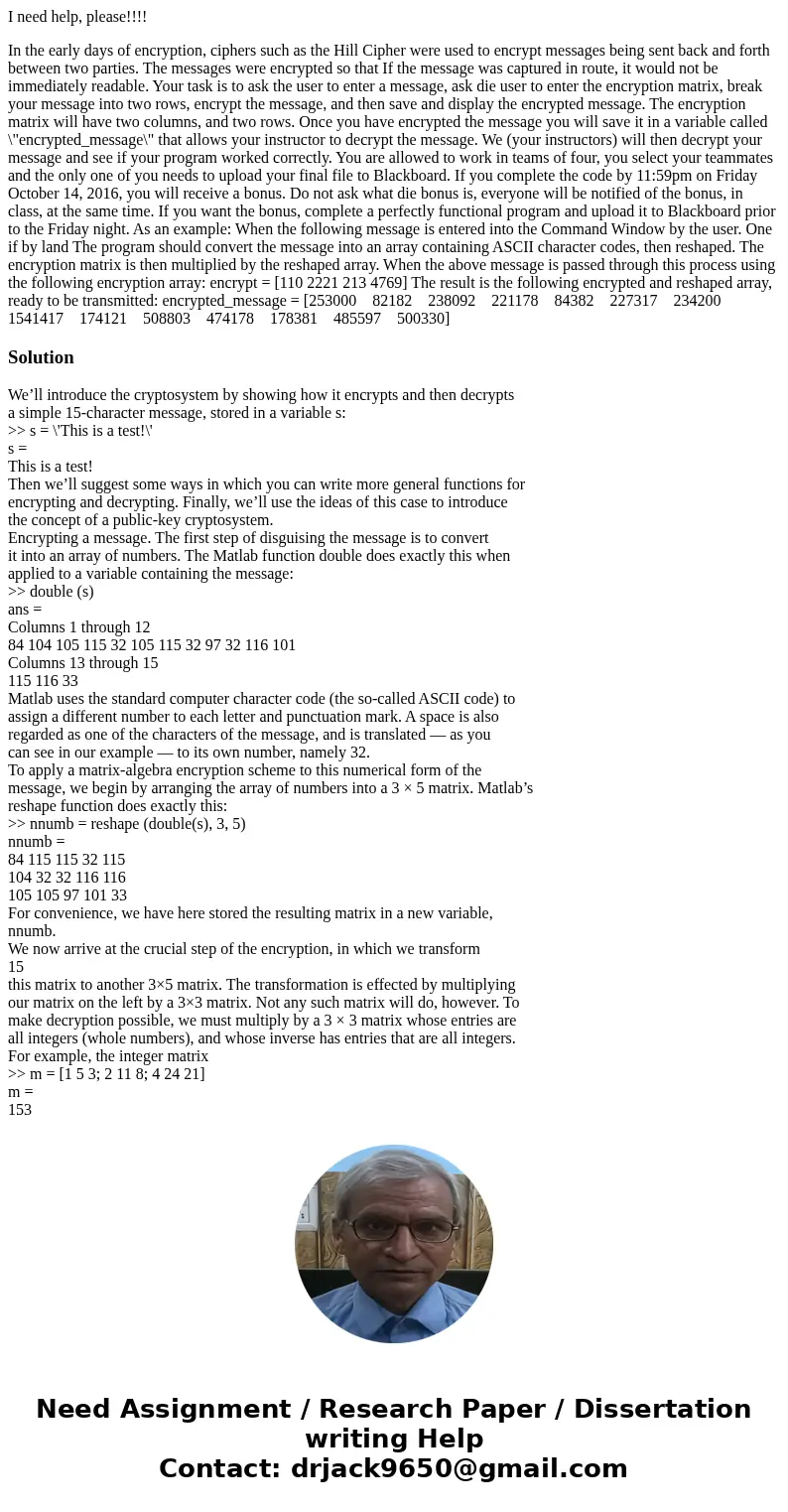
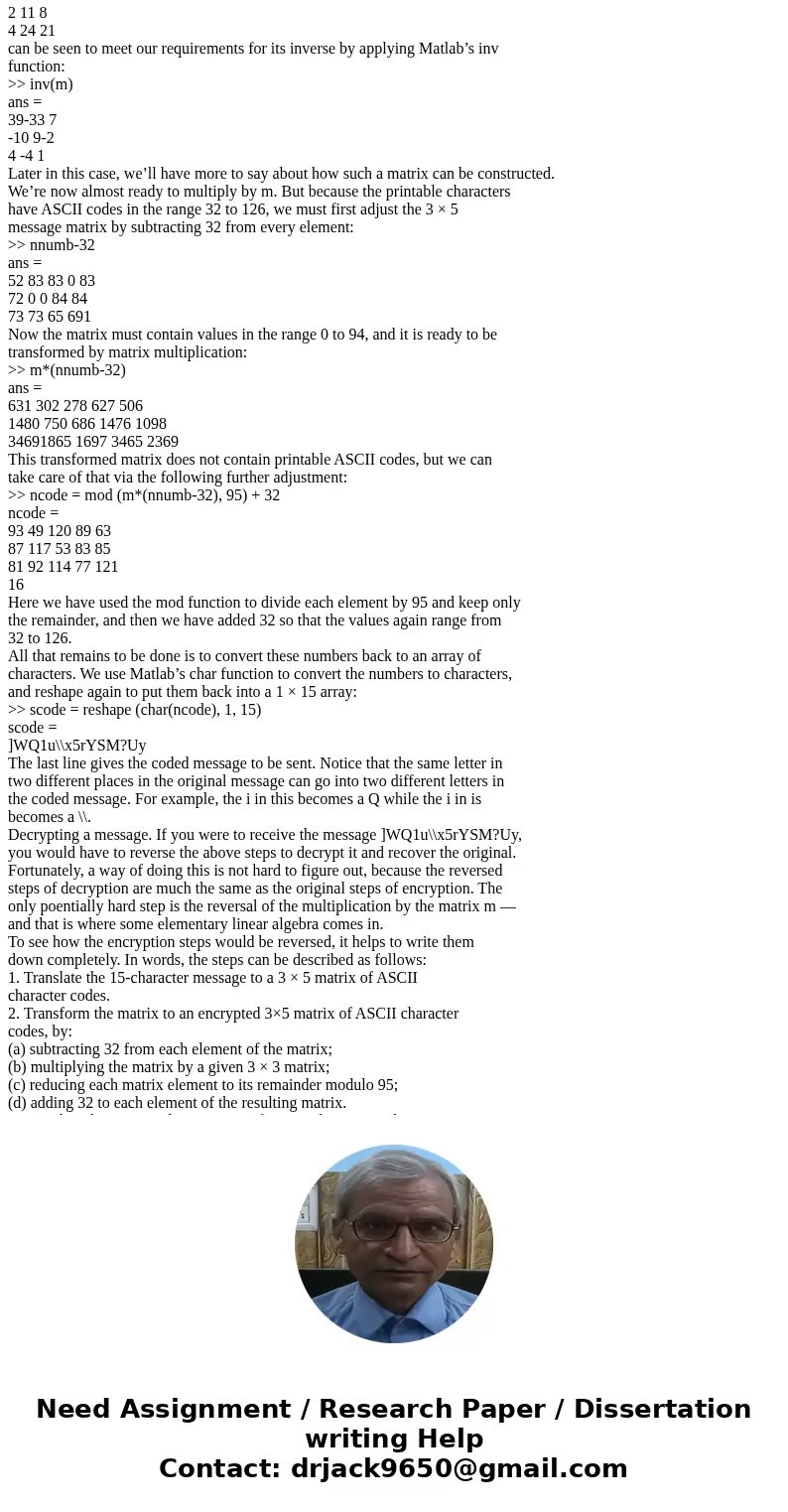
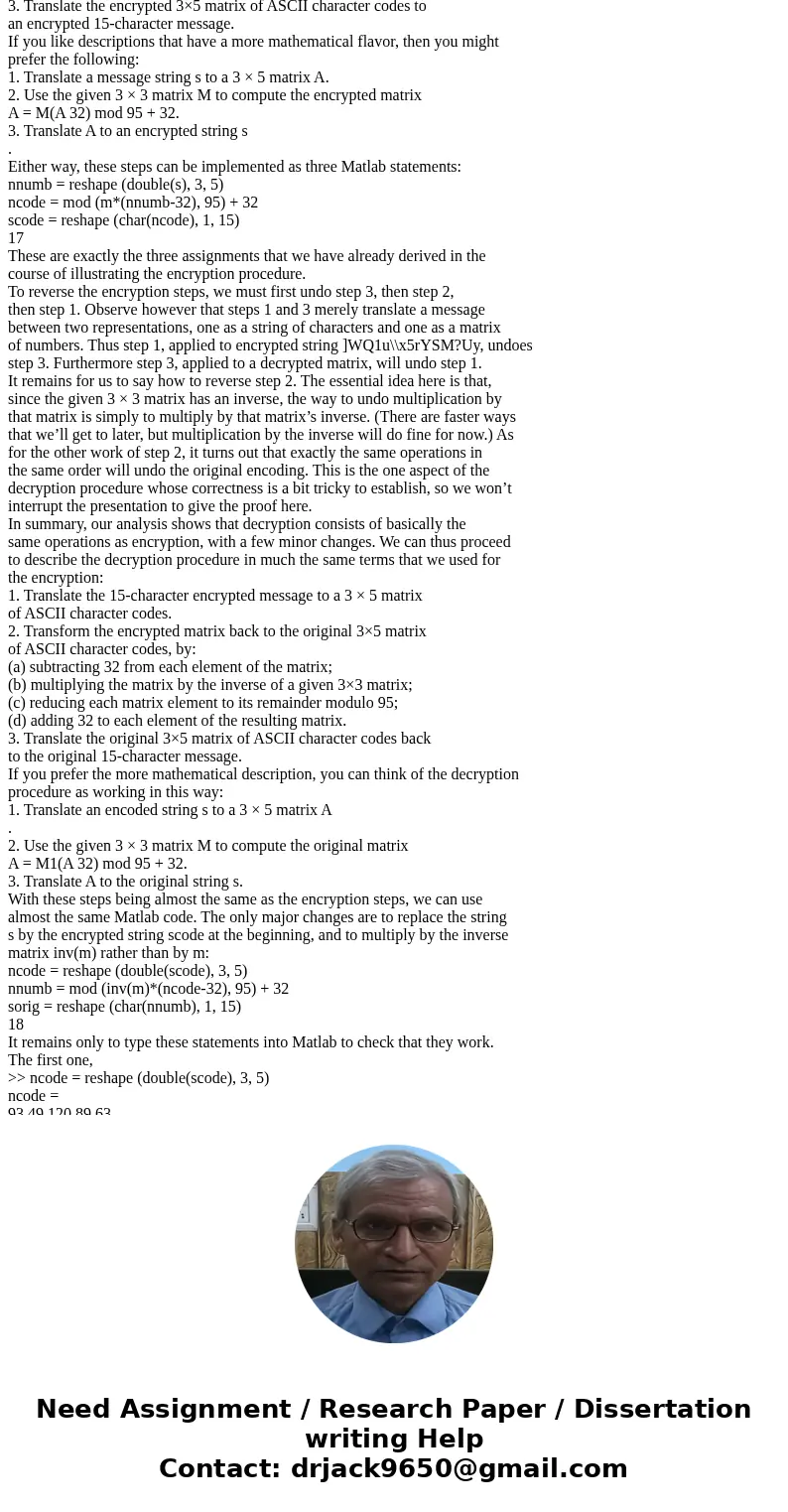
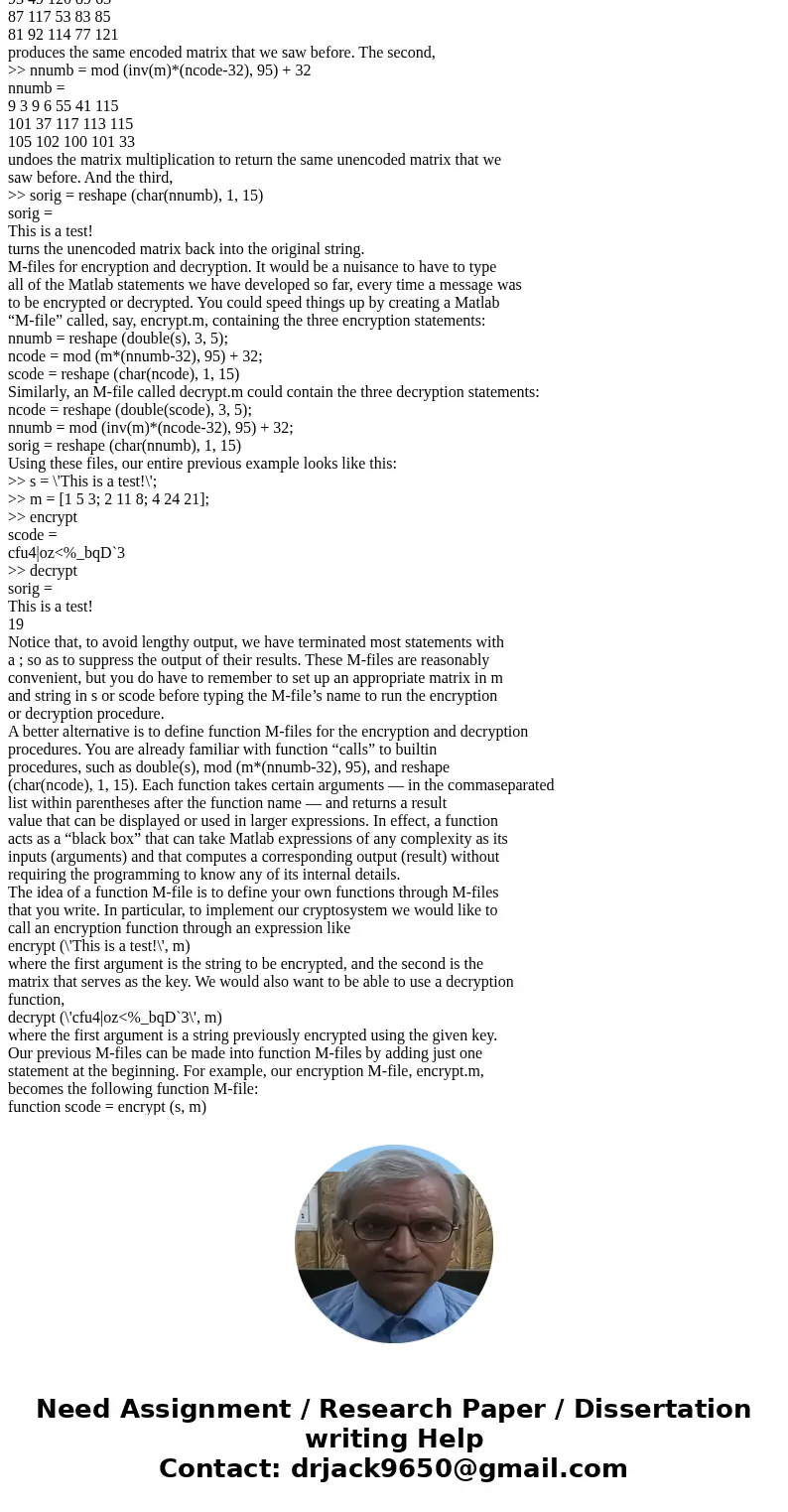
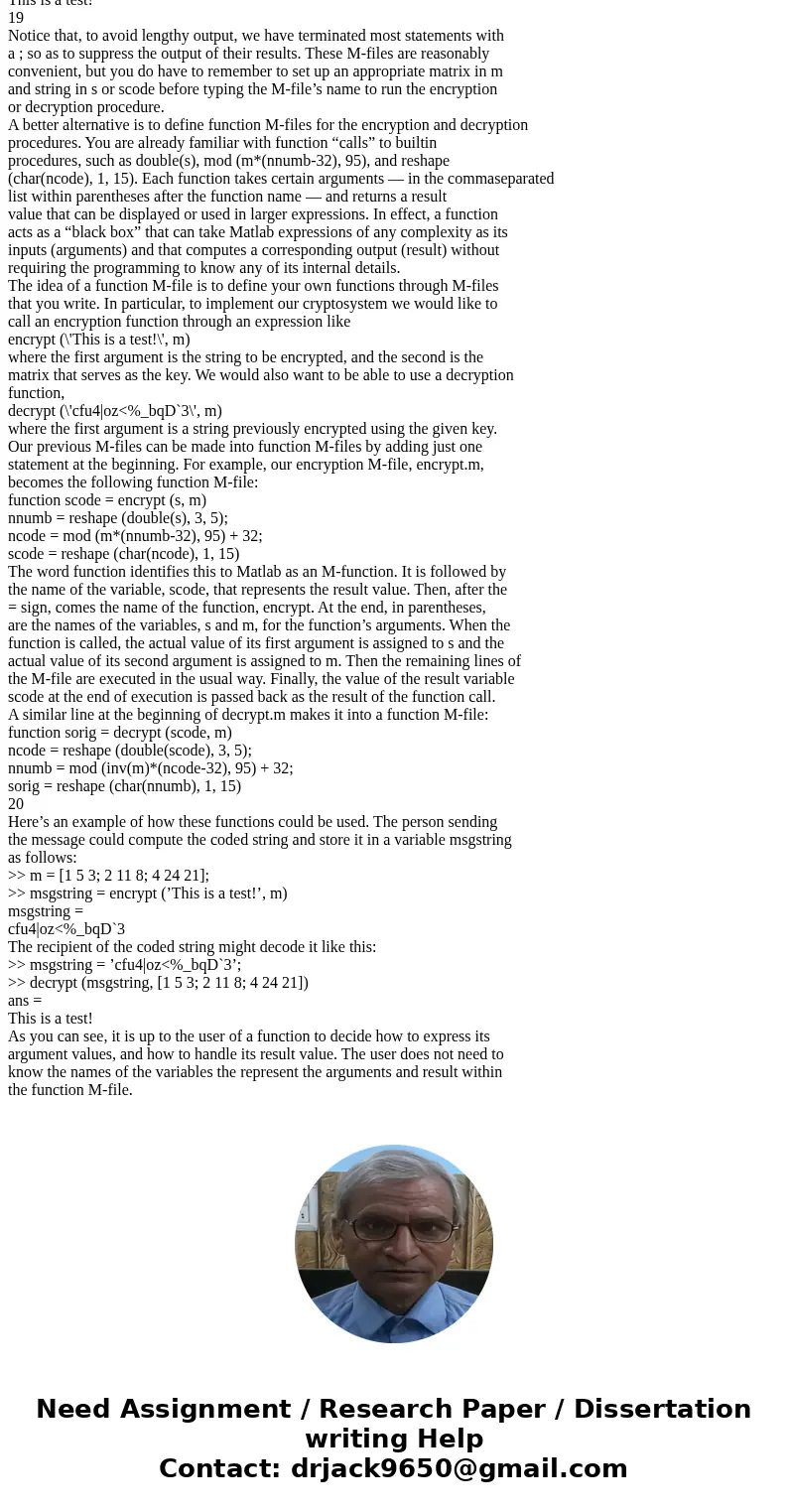
 Homework Sourse
Homework Sourse